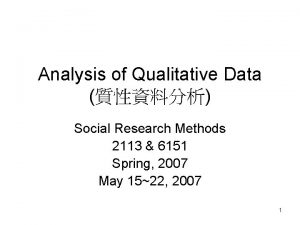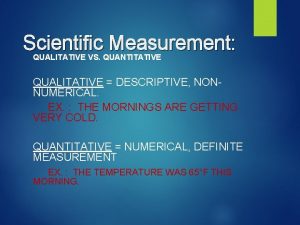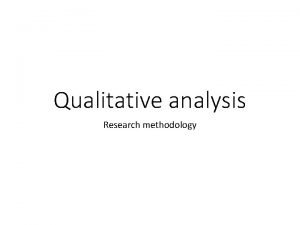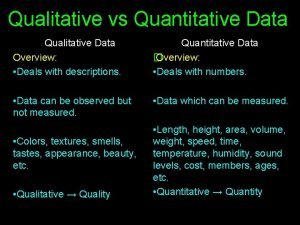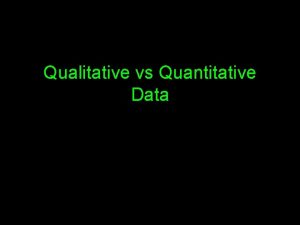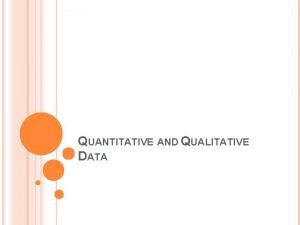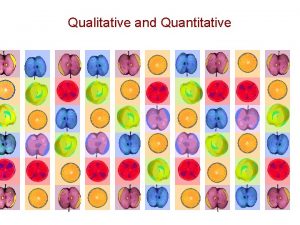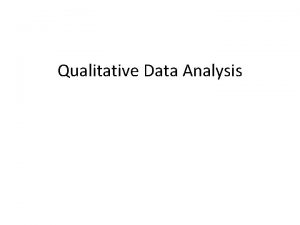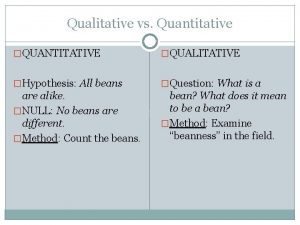How Science Works Qualitative and Quantitative Data Quantitative







- Slides: 7

How Science Works Qualitative and Quantitative Data

Quantitative data � numerical data: generated by counting up the number of people who have responded in a certain way � analysed using statistics. . � Percentages: 45% of British Asian females aged 17 -25 said they had been subjected to racist verbal abuse in the street � Central tendency (averages) women tended to have less authoritarian personalities than men (mean for women: 45/70, men 52/70) � Measures of dispersion (variation within the scores) women tended to show greater variability than men in terms of the how authoritarian they were: (standard deviation = 2. 3 for women and only 1. 2 for men) � Displayed using graphs and charts (histograms, bar charts, box and whisker plots etc) � Quantitative data can also be generated from completing a ‘content analysis’ on qualitative data gathered through an interview for example. � to the transcript of the interview � count up the number of times certain themes or key words are mentioned. � e. g. of the 14 female British Asians interviewed 100% said they felt ‘unwelcome’, 70% said they felt ‘terrified’ , 89% said they had felt ‘threatened’, and 15% said they had been made to feel ‘worthless’.

Strengths of Quantitative Replication and reliability � data is gathered in a structured and controlled manner: should be possible to replicate by using the same standardised procedure, instructions and questions � should be possible to replicate studies which collect quantitative data and thus check for reliability (consistency). Quick and easy analysis � easy and quick to analyse using measures of central tendency and dispersion, and a range of graphs and charts � tables and graphs can be easily communicated to others.

Weaknesses of Quantitative Data Validity � fixed response questions can lead to invalid responses which do not effectively describe the experience of the participants � Need a comprehensive pilot study; allows the researcher to ensure that the alternative answers provided suit a wide range of possible responses from the final sample. � When participants simply have to tick boxes it is very easy for them to become disinterested and disengaged from what they are doing � response set: ticking the same answer time after time when questions follow a similar format (i. e. circling a number) or they may even simply tick answers which don’t really apply to them � they are investing little in answering the questions and therefore may be less inclined to answer them properly

Qualitative data � in the form of words rather than numbers and involves ideas, opinions and attitudes � often ‘tells a story’. � can be collected through asking open ended questions as in an interview or questionnaire � analysed by generating themes; this can be done by carefully transcribing every word and then arranging quotes into categories; these categories and themes and then turned into models or flow charts to show links and relationships between themes (grounded theory) � Often two or more researchers independently analyse the data; their interpretations are compared and the higher the degree of similarity between their analyses, the higher the reliability of the findings and conclusions.

Strengths of Qualitative Data Validity � rich source of data; participants are allowed to describe how they think or feel in their own words � not constrained by the expectations of the researchers which can sometimes be the case in fixed response questions. New ideas � allows researchers to capture new ideas that they were not previously aware of � new information can be used to create more scientific and objective studies with higher validity � researcher gains more in-depth working knowledge of the topic area having worked with participants who have fully explained their experiences.

Weaknesses Qualitative Data Validity � difficult to gather detailed qualitative data as participants often don’t want to give detailed answers � compounded by the fact that some participants may find it more difficult to express their thoughts and feelings verbally in writing or orally � wide range of reasons, including cultural, language and psychological barriers. � data collected may not be generalisable as it only illustrates the views of those who are able to provide more articulate answers. Reliability � hard to replicate as the data collected is a person’s unique interpretation of the world � truly consistent findings are unlikely even if same person is tested at a later date since interpretation changes with experience, over time � evidence divulged is done so within the confines of a relationship between two people, (the participant and the researcher), a different researcher might alter the nature of the information provided and the way in which it is recorded and interpreted � This means it is hard to say whether the results are reliable; also decreases the generalisability.
 Qualitative and quantitative data analysis
Qualitative and quantitative data analysis Data
Data Qualitative vs quantitative measurements
Qualitative vs quantitative measurements Qualitative vs quantitative political science
Qualitative vs quantitative political science Group studied is smaller and not randomly selected
Group studied is smaller and not randomly selected Quantitative and qualitative data difference
Quantitative and qualitative data difference Which of the following is an example of quantitative
Which of the following is an example of quantitative Qualitative vs quantitative
Qualitative vs quantitative

